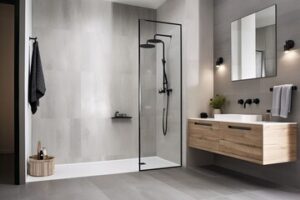The options for Shower Doors are plentiful and diverse. From grand frameless doors that make one feel as if they are within the castle walls to framed and semi-frameless doors, a multitude of styles doth exist for every discerning homeowner.

Choosing the right entry doors for you shower door can elevate your bathroom aesthetics. It also offer an immersive experience to help you find the perfect option for your space, consider your unique needs and design style.
With a minimal metal frame, this door style maximizes the view of the shower interior. Frameless doors are also easier to clean, and can reduce the risk of mold and mildew. However, they can cost more than framed doors and require custom installation.
Like framed doors, frameless shower doors come in a variety of styles and finishes. They can be curved or straight, and they may be coated in a protective surface. They can be hinged or anchored to the wall with clips. Some manufacturers offer “smart” hinges that automatically adjust to the size of the glass.
Choosing the right shower door for your home requires consideration of the size and shape of your bathroom, as well as the decor you’ve chosen. The type of glass you choose will determine how much light comes into the room, and a clear or tinted finish will affect visibility. In addition, the door’s track and hardware will determine how easy it is to open and close.
The biggest drawback to frameless doors is the increased price and complexity of the installation process compared with framed doors. Since the tempered glass is heavier and thicker, it’s important to make sure your contractor has experience installing this type of shower enclosure. A poorly installed door can leak and damage surfaces in your bathroom, leading to costly repairs.
Both framed and frameless doors can last 20 to 30 years with proper care, including daily wipe downs after each shower, and monthly deep cleaning to prevent soap scum build up. In addition, a glass protection coating such as Diamon-Fusion will keep water deposits, minerals and dirt from building up on the surface, which will reduce your cleaning time significantly.
While framed doors have been known to shatter, this is very rare and usually the result of an accident or defect in the glass, improper transportation or installation, or extreme or abrupt temperature change. Although tempered glass is designed to break into rounded pieces rather than jagged shards, these pieces can still cut you if they hit your body. This is why it’s important to always use caution when entering and exiting the shower, never slam or bang the door, and to inspect the doors for cracks and damage regularly.
Framed
Shower areas are important part of most bathrooms, and many homeowners choose to install doors instead of a curtain for a more polished look. There are various configurations and styles of shower doors, but they generally fall into two categories: framed or frameless. Both have positive and negative attributes that should be considered before choosing which style to buy for your bathroom remodel.
Framed shower doors have a metal or plastic frame around the edges of the glass, and they are available in a variety of finishes to match your bathroom decor. They are also available in different shapes and sizes to fit your shower stall. They are typically cheaper to purchase than frameless shower doors, but they may have less versatility in terms of design.
These shower doors can be made of tempered glass or frosted glass, and they can be treated for easy cleaning. They can be installed on a sliding track or as swinging doors that open in one direction using a piano hinge. The disadvantage of this type of shower door is that it tends to collect water underneath the bottom track, which can lead to corrosion of the metal and promote mildew growth. It can also be difficult to clean because soap scum may build up on the track where it meets the wall.
Framed shower doors are easier to install than frameless ones because the glass is lighter and the frames have premeasured openings that fit most shower stalls. However, the frames can be heavy and require special tools to mount. The installation process may take longer if the frames need to be cut or trimmed, and caulking is often needed between the frame and the wall to keep water from leaking. In addition, framed doors can be more expensive to buy than frameless ones because they are often manufactured in mass quantities in overseas factories. They are usually designed to fit a range of widths, and they can be a lower quality than custom-made doors. They are commonly sold to DIYers and builders who are on a budget.
Pivot
Pivot shower doors have a unique design that allows them to open inward and outward, unlike hinged doors. They can be framed or frameless and come with a variety of glass textures, sizes and options for privacy and functionality. They also have a number of hinge options in color and metallic finishes which allow you to match your bathroom décor.
Frameless shower doors have the advantage of offering a clear view and a seamless appearance in your bathroom. They can be used in any type of shower enclosure, whether it’s a walk-in tub or a standard shower stall. They’re easy to clean and offer a more modern style. They can also be installed on a corner shower if you have enough space to accommodate one.
They have a smooth surface and don’t require any tracks, which makes them easier to maintain than sliding doors. They’re also less likely to catch water or dirt, which could lead to mold and mildew growth. However, they can be more difficult to open than other types of shower doors. They’re also not as sturdy as other styles, so they may not be suitable for older or handicapped people.
Like all shower doors, pivoting doors should be made of tempered glass to ensure safety and durability. Tempering is a process that involves applying controlled thermal or chemical treatments to the glass, which increases its strength and hardness. This makes it more durable than regular plate glass, which can splinter into jagged pieces. In addition to the glass, there are several shower base options available including acrylic, expanded polystyrene, cultured marble and tile.
Choosing the right shower door for your bathroom will depend on several factors, including the layout of the room and your personal preferences. A hinged or bypass door will work well in smaller shower stalls, while French doors may be a better option for larger spaces. However, the most important factor is choosing a style that will be both functional and beautiful in your bathroom.
Fixed
One of the most common kinds of glass shower doors for bathrooms is a fixed glass door. This is a modern design that can be fabricated into smaller sizes, making it ideal for small bathrooms. It also comes in bi-fold designs that allow the door to open and shut for comfortable entry. Fixed doors are available in a variety of glass types and finishes to complement any bathroom decor. Some are even frosted for privacy or have a patterned finish to add visual interest. These doors can be easier to keep clean since they do not have any nooks and crannies for dirt to collect in.
There are many different types of hinges that can be used to support a fixed shower door. You will want to find a durable and reliable option that can handle the weight of your doors. Look for hinges that are made from stainless steel or another hardwearing material. You will also want to consider whether or not you want a self-closing door hinge, which can help prevent water leakage after each use. Some hinges are designed specifically for neo-angle or corner shower stalls, which may require more stability than a standard hinge.
The minimal frame of a fixed shower panel makes it an elegant addition to your home. It creates a clear separation between your shower space and the rest of the bathroom, which can elevate the overall aesthetic of your bathing area. Additionally, the glass shower panel takes up less floorspace than a sliding door or a frameless pivot door, making it an excellent choice for cramped spaces.
For homeowners who are concerned about the environmental impact of their renovations, fixed glass shower doors may be a good choice. This is because they are made from recycled materials, such as sand, limestone, and sodium carbonate. Additionally, they are non-toxic and have a low-carbon footprint.

